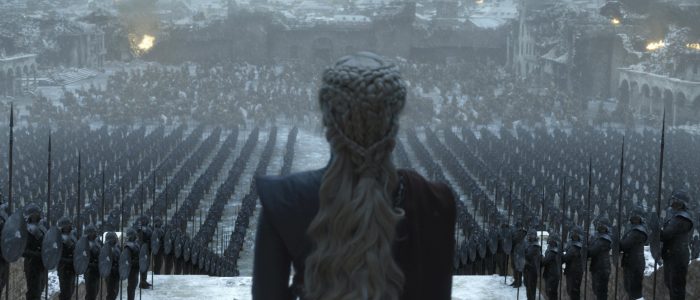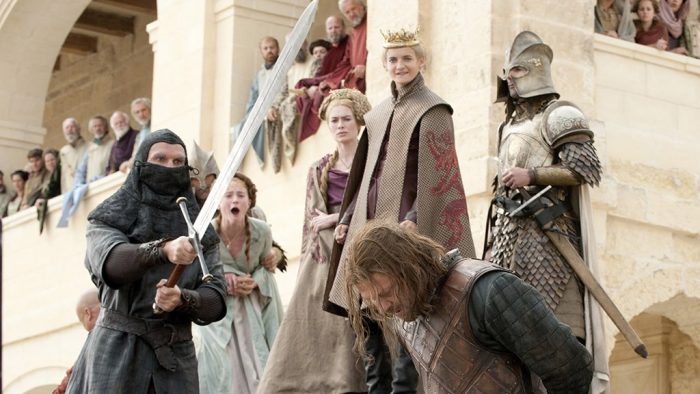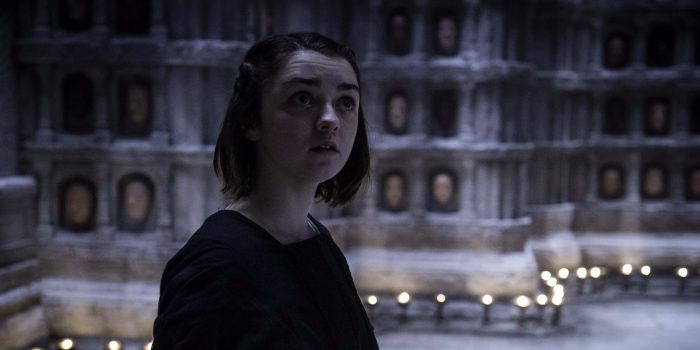
Game of Thrones is a show that is profoundly of its time. It’s a sword made of the finest Valyrian steel that has cut through pop culture but is nonetheless two-edged in its relation to and reflection of the cultural zeitgeist. The story begun in George R.R. Martin’s A Song of Ice and Fire novels drew from cycles of history and fictional tropes to present what’s been called “Realpolitik in a fantasy world.” It was the Wars of the Roses meets The Lord of the Rings; but whereas author J.R.R. Tolkien was a World War I veteran writing concurrently with World War II, Martin is a writer who was a conscientious objector in Vietnam and whose books spawned a television series that would air in the aftermath of the Iraq War.
Game of Thrones premiered on HBO a year into the 2010s … and now its watch is ended in the last year of the decade, before the 2020s begin. Amid the real-world problems of 2019, there’s a tendency sometimes to dismiss entertainment talk as trivial, but entertainment also has a way of preserving history — or the agreed-upon lie of it — beyond the day’s headlines. It’s as much a time capsule as it is a means of escape.
When people look back at Game of Thrones, they will see an elaborate map of mythology where the grinding gears of cities rose up with plot twists to complicate (and often end) the lives of memorable characters. It’s quite possible that they will also see an ugly mosaic of all that was/is wrong with the world. If, as Vulture recently posited, this prestige drama represents “the last show we’ll watch together,” then before the watercooler drains, it will have left us with an artifact that speaks volumes about the era in which we’re living.

Thrills and Chills in the Age of Uncertainty
At its best, Game of Thrones leveraged intrigue and world-building into an engrossing geopolitical saga with real-world overtones (this, despite the obvious fantastical shadings like fire-breathing dragons). It showed us a morally grey landscape where even the noblest characters could be doomed by their own tragic choices.
In the beginning, before we met the Night King in Season 4, there was no Sauron-like foe for the heroes to rally against. The White Walkers were there from the very first scene, but whether it was for organic plot reasons and/or a lack of budget for CGI, the supernatural menace of those ice zombies was more a background threat, among other Byzantine human threats.
In this way, Game of Thrones was the perfect show for a paranoid, post-9/11 world where the Nazis of wars past have given way to less clear-cut enemies who lurk in the shadows and strike when we least expect it. “The night is dark and full of terror[ist]s.” We live in a time of increasing uncertainty; the show tapped into that with its wild unpredictability, the way it destabilized the viewer by killing off its ostensible main character and giving us events like the Red Wedding.
If you think about how much mainstream appreciation the horror genre has been enjoying in recent years, it’s not hard to see the horror elements of Game of Thrones and stories like it as a release valve for troubled times. The show premiered about six months after The Walking Dead (the two shows would sometimes overlap in the same Sunday night time slot); and while I would argue that “Hardhome” was a scarier zombie apocalypse than anything we ever saw on AMC, there’s probably a correlation to be drawn between the emotional hardening Rick Grimes underwent and the one Game of Thrones viewers underwent as they witnessed their own naive Rick analog get played for a fool and beheaded.
Seeing Sean Bean’s character, the show’s poster boy, on an old Entertainment Weekly list of the most shocking TV deaths is what first made me interested in watching Game of Thrones. Only later, in-between seasons, would I start reading Martin’s novels, decorating my bookshelf with those thick tomes and listening to Roy Dotrice narrate a couple of the audiobook versions.
Ned Stark’s demise remains spoiler-proof because it’s thematically rich. You think he’s the protagonist. He’s like Marion Crane in Psycho, only instead of the spooky Bates Motel, he ventures down the King’s Road into the shark-infested waters of King’s Landing.
With Ned, there’s a real lack of foresight at play. Out of honor or a misguided sense of it, he lies to his loved ones about Jon Snow’s parentage … and doesn’t withhold information from his enemies about Joffrey’s parentage. Being forthcoming with all the wrong people makes him an easy mark for Cersei Lannister and Littlefinger, two expert, city-dwelling players of the game of thrones. It’s a fatal blunder when he tips his hand to Cersei, giving her the heads-up that he’s learned the truth about Joffrey.
Though it leaves the viewer reeling at first, when you do the math later, it makes perfect sense that a simple, idealistic man like Ned would get outmaneuvered by these Machiavellian forces. His false confession and decapitation on the steps of the Great Sept of Baelor, the center of religious worship in King’s Landing, takes us beyond good and evil. That’s the post-modern territory where Games of Thrones lives along with its viewers.
In later seasons, this same location, the Great Sept, will serve as the site of important weddings and funerals—some of which are travesties, like the one that sees Ned’s own daughter marry into the very family that is responsible for his death. It’s here, also, that the Sparrows, Martin’s version of the medieval Catholic Church, will revive the power of the Faith Militant (a group whose name quickly conceptualizes yet another social force that has shaped the current millennium). With the modern Catholic Church embroiled in sex abuse scandals, Ned’s demise, the spilling of his blood on those steps, would seem to christen the Sept of Baelor as a foundation of lies: one more failing structure in a world full of them.
Welcome to the 2010s. Ned Stark’s death showed the at-home audience how honor alone was not virtue enough to survive. Playing the game of thrones meant using intelligence and pragmatism to navigate an amoral, sometimes cheerfully immoral, human chessboard.
In the absence of Ned — and his son Robb, who seemed poised to become the next noble northern leader until the Red Wedding — what was left on Game of Thrones were “cripples, bastards, and broken things.” Tyrion Lannister, himself a dwarf, spoke fondly of them. The one-handed Kingslayer, the disgraced northern lord affected with greyscale … lost souls like these were the heart of Game of Thrones.

Women in the Hall of Faces
Game of Thrones built its brand as a drama where you never knew what might happened next. It wielded capriciousness as a storytelling strength, however the show was not without its problematic aspects. These went over and above the occasionally dodgy writing in later seasons.
From its first season onward, the show grew increasingly cruel in its depiction of sex, violence, and sexual violence. Reams have been written about this; it’s a hot-button topic that takes up much space in the online part of the time capsule. Remember Ros, the red-haired prostitute who lived and moaned through the infamous “sexposition” scene in Littlefinger’s brothel (S1E7, “You Win or You Die”), only to wind up becoming a bedroom crossbow target for King Joffrey (S3E6, “The Climb?”)
Ros was the face of a legion of show victims, whose skinned visages wouldn’t look out of place if they were mounted on pillars in the Hall of Faces in Braavos. Not all of these victims were women — as Theon Greyjoy’s protracted torture and castration in Season 3 goes to show — but as the onscreen rapes compounded, gender dynamics did become an inseparable part of the discussion surrounding Game of Thrones.
Even with Arya taking out the Night King and Sansa left to rule the North in the end, the wobbly character arc of Daenerys Targaryen (more on that later) has effectively looped us back to the point where that’s once again become the defining sociopolitical argument in many critical appraisals of the show. To be clear, gender dynamics weren’t an issue for every viewer on the street; I’ve certainly talked to female fans who were less concerned with that than they were basic storytelling issues. Unless you’re wildly insensitive, however, you’d have to recognize that it could be triggering for some viewers to see rape or even feel it threatened.
In a story about power and the pursuit of it, it makes sense from a theoretical standpoint that a pervasive crime of power like sexual assault might factor in as a plot device. There are ways to go about approaching that kind of subject matter: Netflix’s Jessica Jones is one example that comes to mind of a show that did it right, inasmuch as it refused to portray it visually or treat it as positively transformative for its acerbic title character, a mighty Marvel superhero who also happened to be a rape survivor.
Game of Thrones, by contrast, never shied away from showing or describing the act, with three major female characters — Daenerys, Cersei, and Sansa — enduring it, to name but a few. The absolute nadir was Sansa’s wedding-night violation and the focus on Theon’s reaction to it in the Season 5 episode, “Unbowed, Unbent, Unbroken,” which was, it’s worth noting, the single worst-reviewed episode of the series … until its penultimate episode last week, “The Bells.”
Martin’s books are actually much worse in terms of rape. There are about four times as many instances of it on the page as there on the screen, but there’s something about witnessing it acted out physically (with a girl we’ve watched grow up like our fictional sister, no less) that renders it vivider in the imagination.
Again, women weren’t the only meat-grinder victims in the Hall of Faces on Game of Thrones, but they inhabited their own special wing in that world of hurt. Being married off to a sadist or objectified as a crossbow target is something quite different from being a willing participant in a duel to the death. When we first met Oberyn Martell, he waltzed right into a sexy foursome; when last we saw him, the Mountain was gouging his eyes out and crushing his skull. Yet he had full agency before he met his ignominious end.
Looking back, what made the sexual violence (as opposed to just plain violence of the eye-gouging variety) all the more troubling was how the show had such a leering quality to it, even when it was in its default, non-rape mode. With a male author, male showrunners, and a writer’s room that eventually shifted to all-male, as well, Game of Thrones is a series that proved itself incapable of truly separating from the male gaze.
Behind the scenes, producers seeking to “represent the pervy side of the audience” vied for the inclusion of more full frontal nudity. (This choice of verbs, “represent,” seems particularly droll given how the show only made room in its sprawling Eurocentric cast for two significant black characters, one of whom, Missandei, sadly got fridged). Throughout the series, there were countless bits of physical and verbal posturing wherein characters seemed to act as hedonistic mouthpieces, espousing the worldview that women and wine, flesh and ale, were the only pleasures to be had in an otherwise meaningless hellscape.
Tyrion and Bronn’s crass dialogue was part of their charm, but even they weren’t exempt from the ubiquitous corruption in Westeros, a place where fan-favorite characters were not above strangling their former lovers (or committing patricide) and where their best friends were primarily motivated by money.
What we see here, you understand, is very much a hyper-reality where all the ills of the world are magnified and dramatized and fed back into the world until it chokes on the entertainment. Again and again, like flesh-rending lashes from a cat o’ nine tails, we were shown how violent and unforgiving this hyper-reality could be. But was the ethos of it really so different from that of our own mundane world?
Continue Reading Game of Thrones >>
The post The Best and Worst Aspects of ‘Game of Thrones’ Serve as a Time Capsule of the 2010s appeared first on /Film.
from /Film http://bit.ly/2QfAzKM

0 Comments